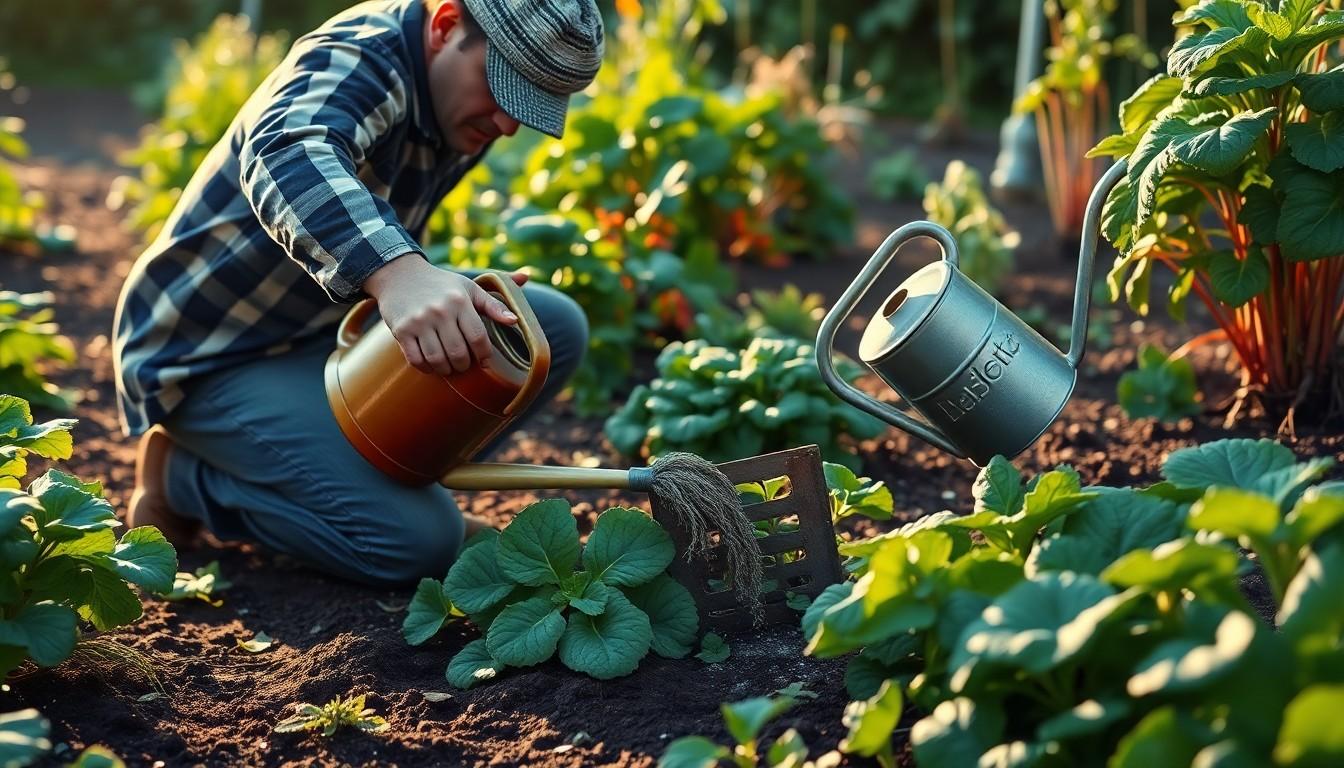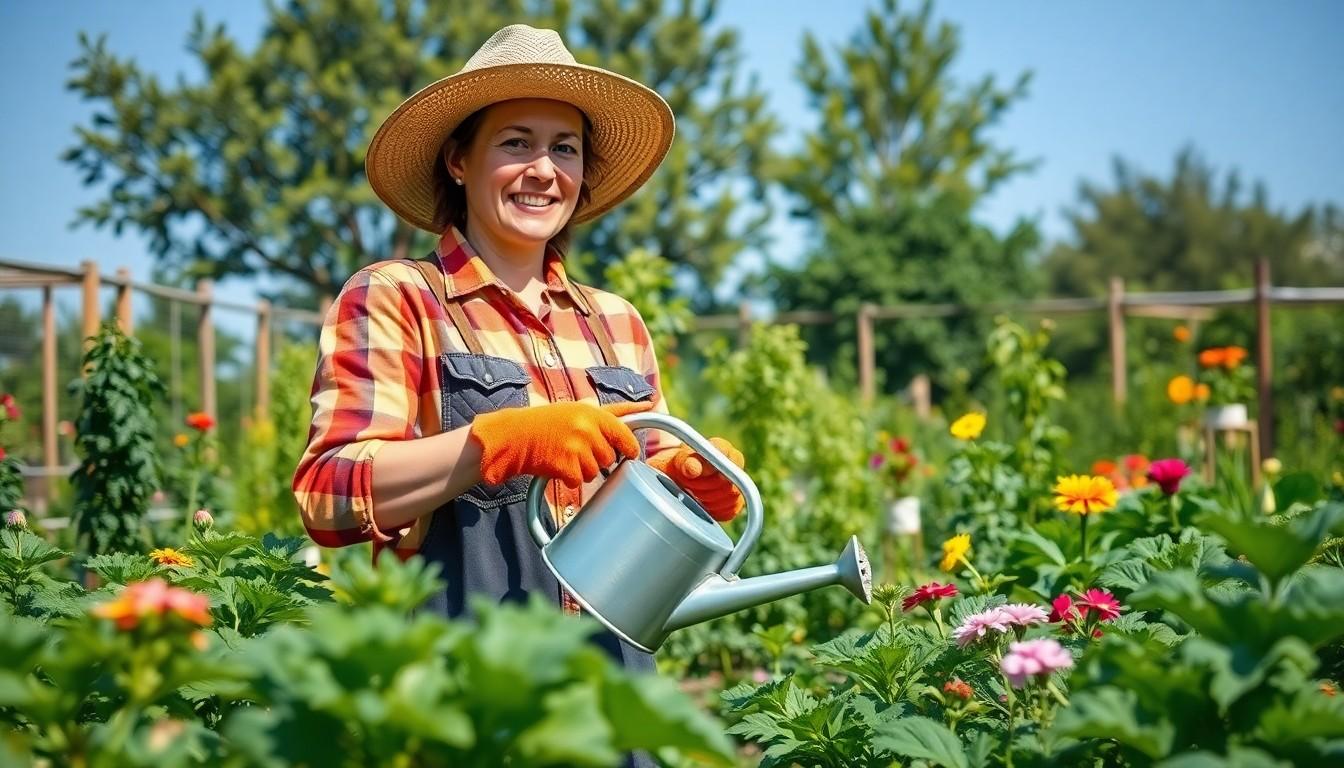Watering a vegetable garden might seem as simple as grabbing a hose and letting it flow, but timing is everything. Imagine your plants sipping a refreshing drink just when they need it most—sounds dreamy, right? The best time of day to water can make the difference between a thriving garden and a sad patch of wilted greens.
Understanding Plant Water Needs
Plants require water at specific times to maximize their growth. Various factors impact when gardeners should provide hydration.
Factors Influencing Watering Time
Soil type influences water retention. Sandy soils drain quickly, necessitating more frequent watering compared to clay soils, which hold moisture longer. Plant type also matters. Leafy greens thrive with consistent moisture, while root vegetables prefer watering less frequently. Gardeners should consider local climate, as seasonal changes can affect evaporation rates. Lastly, growth stage impacts water needs; seedlings often require more attention than mature plants.
Effects of Temperature and Sunlight
Temperature plays a crucial role in plant hydration. High temperatures increase evaporation, leading to faster moisture loss in the soil. This loss can stress plants, making more frequent watering essential. Sunlight exposes plants to direct heat, impacting water needs. During sunny days, plants may require additional watering in the afternoon to prevent wilting. Monitoring forecasted temperatures helps gardeners adjust their watering schedules, ensuring plants receive adequate hydration when conditions demand it.
Benefits of Morning Watering

Morning watering offers several advantages for a vegetable garden. Fewer evaporative losses occur, allowing more water to penetrate the soil. Temperatures stay cooler during early hours, leading to reduced evaporation rates compared to later in the day. This efficiency means plants absorb water better, maintaining optimal moisture levels.
Reduced Evaporation
Less evaporation in the morning results in increased water availability for plants. With temperatures generally lower, water remains on the soil surface longer, fostering deep root absorption. Higher evaporation tends to occur as the sun rises and temperatures increase. Therefore, watering before hot weather sets in minimizes wasted water. The strategy ensures the garden remains hydrated, supporting plant health throughout the day.
Enhanced Nutrient Uptake
Morning watering encourages stronger nutrient uptake in vegetables. Soil moisture promotes better nutrient solubility, enhancing accessibility for plant roots. When water saturates the soil before the heat intensifies, it creates favorable conditions for nutrient movement. Increased moisture content supports the movement of essential nutrients toward plant roots, fostering growth and development. Plants also exhibit improved vigor and resilience with adequate morning hydration.
Afternoon Watering: Pros and Cons
Watering in the afternoon offers specific advantages and disadvantages. It allows gardeners to fit their schedules, especially if mornings are busy. Plants benefit from additional hydration during the hottest part of the day, which can be useful for maintaining moisture levels.
When It Might Be Beneficial
Afternoon watering can support plants during a heat wave. Gardeners may notice that temperatures peak in the late afternoon, increasing water demands. Providing hydration during this time can prevent immediate wilting. It also aids in cooling the soil, which contributes to plant health. Some plants thrive on a slow, deep soaking in the afternoon, promoting root growth. If local humidity levels are high, watering later in the day may reduce evaporation and improve water retention.
Risks of Heat Stress
Heat stress poses a significant risk when watering in the afternoon. High temperatures can lead to rapid evaporation, reducing the effectiveness of watering. Moisture lost to evaporation means less water reaches the roots, ultimately stressing the plants. Moreover, watering during peak sunlight can cause leaves to scorch or burn. Foliage, when wet and exposed to intense sunlight, can suffer damage. Therefore, gardeners must monitor conditions to avoid additional stress on their plants.
Evening Watering: Is It Recommended?
Evening watering can be a topic of debate among gardeners. It presents both opportunities and challenges that gardeners should consider.
Potential Issues with Fungal Diseases
Watering in the evening may lead to prolonged moisture on foliage. Such conditions can increase the likelihood of fungal diseases developing. Fungal pathogens thrive in humid environments, making wet leaves a potential breeding ground for issues like powdery mildew and root rot. Gardeners focused on evening watering must pay attention to plant health and symptoms of disease. Regularly inspecting for signs of infection can help manage these risks.
Soil Moisture Considerations
Soil moisture retention plays a key role when watering in the evening. Moisture can persist in the soil overnight, allowing the plants to absorb water effectively. However, excessive watering can saturate the soil, which may cause root problems. It’s important to assess the soil’s drainage and moisture levels consistently. Using mulch can help regulate soil temperature and reduce evaporation, supporting healthier watering practices. Balancing these factors strengthens plant growth while preventing overwatering.
Best Practices for Watering
Effective watering practices enhance vegetable garden health. Focus on using the right methods and maintaining an appropriate frequency.
Methods of Watering
Drip irrigation provides targeted hydration directly to plant roots. This system minimizes evaporation and conserves water. Soaker hoses also deliver moisture gradually, ensuring it penetrates the soil effectively. For smaller gardens, hand watering using a watering can allows for precision, although it requires more effort and time. Lastly, a sprinkler system can cover larger areas efficiently. Automated timers for sprinklers help gardeners manage watering times, promoting consistency and preventing overwatering.
Frequency of Watering
Gardeners should consider soil moisture levels and plant needs when determining frequency. Generally, watering two to three times per week suffices for most vegetable gardens. During hot, dry periods, daily watering may become essential to prevent wilting. Checking soil moisture with a finger test helps gauge the need; if the top inch feels dry, it’s time to water. Adjustments also depend on plant types; leafy greens often require more moisture, while root vegetables can tolerate slightly drier conditions. Regular monitoring ensures optimal hydration, supporting healthy plant growth.
Conclusion
Timing is crucial when it comes to watering a vegetable garden. By understanding the specific needs of plants and considering environmental factors, gardeners can optimize their watering schedules for better growth. Morning watering often proves to be the most effective method, but afternoon and evening options also have their place depending on conditions.
Utilizing targeted irrigation techniques like drip systems can further enhance water efficiency. Regularly checking soil moisture ensures that plants receive the right amount of hydration. With the right approach, gardeners can cultivate a thriving vegetable garden that flourishes throughout the growing season.

